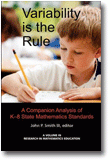
Variability is the Rule
A Companion Analysis of K-8 State Mathematics Standards
Edited by:
John P. Smith III, Michigan State University
A volume in the series: Research in Mathematics Education. Editor(s): Denisse R Thompson, University of South Florida. Mary Ann Huntley, Cornell University. Christine Suurtamm, University of Ottawa.
Published 2010
In response to No Child Let Behind, states have developed mathematics curriculum frameworks that outline their intended curriculum for grades K–8. While some have indicated that districts or individual schools may use their framework as a model for specific curricular programs, others have taken a more prescriptive or even mandatory stance. Collectively, these frameworks present a sense of the national mathematics program and what we expect students learn.
This volume follows The Intended Curriculum as Represented in State Mathematics Curriculum Standards: Consensus or Confusion? (Reys). While the Reys volume focused on number and operations, algebra and reasoning strands, the Smith volume analyzes geometry, measurement, probability, and statistics strands. It also presents an analysis what verbs used tell us about the cognitive demand of grade level expectations. This volume, even more than the Reys volume, emphasizes the theme of variability in the content, expression, and clarity of grade level expectations across the states.
As the nation moves toward implementation of the Common Core Standards, this volume highlights some of the challenges teachers and other school personnel face in interpreting mathematics grade-level standards as goals for classroom teaching. The shift from 50 state standards to one document does not resolve this basic challenge.
CONTENTS
Acknowledgments. 1. Introduction: An Analysis of State Standards in Two Mathematical Domains, John P. Smith III, Gregory Larnell, and James E. Tarr. 2. An Analysis of K-8 Measurement Grade Level Expectations, Sarah E. Kasten and Jill Newton. 3. The Treatment of Transformations in K–8 Geometry and Measurement Grade Level Expectations, Sasha Wang and John P. Smith III. 4. An Examination of K-8 Geometry State Standards Through the Lens of the van Hiele Levels of Geometric Thinking, Jill Newton. 5. Verbs and Cognitive Demand in K–8 Geometry and Measurement Grade Level Expectations, Gregory V. Larnell and John P. Smith III. 6. The Statistical Process: A View Across K–8 State Standards, Jill Newton, Aladar Horvath, & Leslie Dietiker. 7. An Analysis of K–8 Probability Standards, Shannon Dingman and James E. Tarr. 8. Major Lessons from the Second Round of Standards Analyses, John P. Smith III, Glenda T. Lappan, and James E. Tarr. Appendices. References. About the Authors.
-
Paperback978-1-61735-197-6
Web price: $45.04 (Reg. 52.99)
-
Hardcover978-1-61735-198-3
Web price: $80.74 (Reg. 94.99)
- eBook9781617351990

-
 A Five-Year Study of the First Edition of the Core-Plus Mathematics Curriculum
A Five-Year Study of the First Edition of the Core-Plus Mathematics Curriculum
-
 Approaches to Studying the Enacted Mathematics Curriculum
Approaches to Studying the Enacted Mathematics Curriculum
-
 Digital Curricula in School Mathematics
Digital Curricula in School Mathematics
-
 International Perspectives on Mathematics Curriculum
International Perspectives on Mathematics Curriculum
-
 International Perspectives on Mathematics Teacher Education
International Perspectives on Mathematics Teacher Education
-
 Language and Mathematics Education
Multiple Perspectives and Directions for Research
Language and Mathematics Education
Multiple Perspectives and Directions for Research
-
 Researching Pedagogy and Practice with Canadian Mathematics Teachers
Researching Pedagogy and Practice with Canadian Mathematics Teachers

